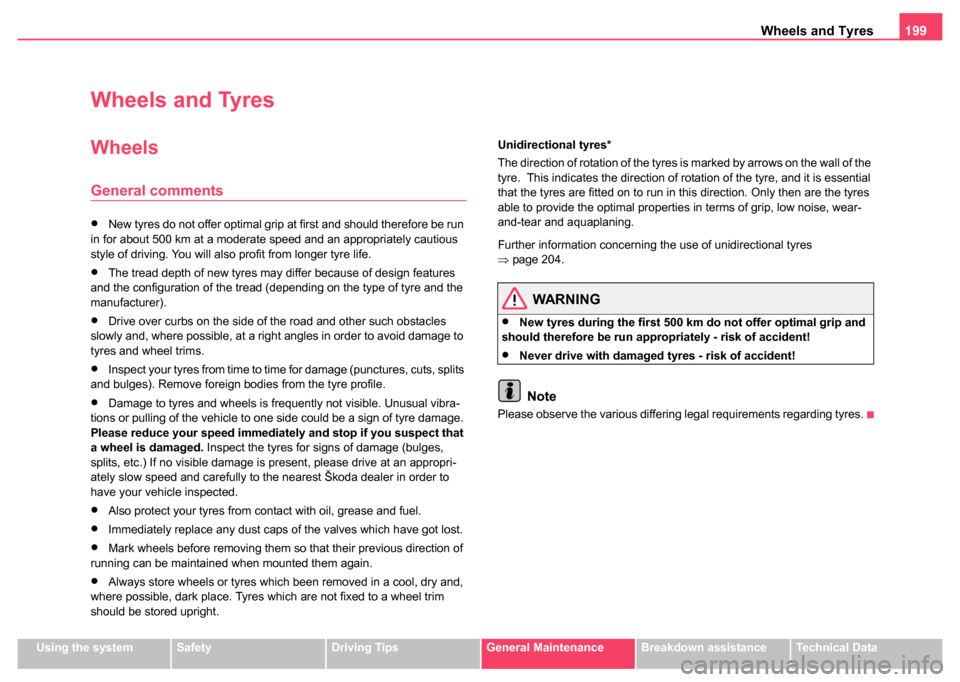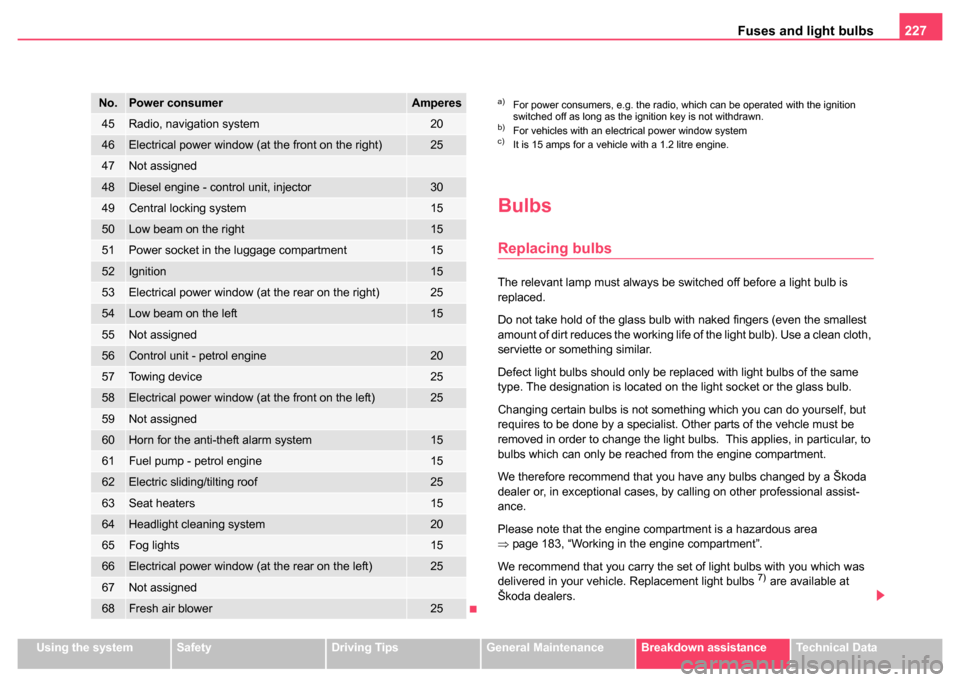fuel type SKODA FABIA 2004 1.G / 6Y Owner's Manual
[x] Cancel search | Manufacturer: SKODA, Model Year: 2004, Model line: FABIA, Model: SKODA FABIA 2004 1.G / 6YPages: 247
Page 200 of 247

Wheels and Tyres199
Using the systemSafetyDriving TipsGeneral MaintenanceBreakdown assistanceTechnical Data
Wheels and Tyres
Wheels
General comments
•New tyres do not offer optimal grip at first and should therefore be run
in for about 500 km at a moderate speed and an appropriately cautious
style of driving. You will also profit from longer tyre life.
•The tread depth of new tyres may differ because of design features
and the configuration of the tread (depending on the type of tyre and the
manufacturer).
•Drive over curbs on the side of the road and other such obstacles
slowly and, where possible, at a right angles in order to avoid damage to
tyres and wheel trims.
•Inspect your tyres from time to time for damage (punctures, cuts, splits
and bulges). Remove foreign bodies from the tyre profile.
•Damage to tyres and wheels is frequently not visible. Unusual vibra-
tions or pulling of the vehicle to one side could be a sign of tyre damage.
Please reduce your speed immediately and stop if you suspect that
a wheel is damaged. Inspect the tyres for signs of damage (bulges,
splits, etc.) If no visible damage is present, please drive at an appropri-
ately slow speed and carefully to the nearest Škoda dealer in order to
have your vehicle inspected.
•Also protect your tyres from contact with oil, grease and fuel.
•Immediately replace any dust caps of the valves which have got lost.
•Mark wheels before removing them so that their previous direction of
running can be maintained when mounted them again.
•Always store wheels or tyres which been removed in a cool, dry and,
where possible, dark place. Tyres which are not fixed to a wheel trim
should be stored upright. Unidirectional tyres*
The direction of rotation of the tyres is marked by arrows on the wall of the
tyre. This indicates the direction of rotation of the tyre, and it is essential
that the tyres are fitted on to run in this direction. Only then are the tyres
able to provide the optimal properties in terms of grip, low noise, wear-
and-tear and aquaplaning.
Further information concerning the use of unidirectional tyres
⇒
page 204.
WARNING
•New tyres during the first 500 km do not offer optimal grip and
should therefore be run approp riately - risk of accident!
•Never drive with damaged tyres - risk of accident!
Note
Please observe the various differing legal requirements regarding tyres.
Page 205 of 247

Wheels and Tyres
204
Winter tyres
The handling of your vehicle will be significantly improved when driving on
wintry roads and at temperatures below 7 °C if you fit winter tyres.
Summer tyres do not offer the same grip on ice and snow because of their
construction (width, rubber blend, tread pattern). This particularly applies
to vehicles which are equipped with low-profile tyres or high-speed
tyres (code index H or V on wall of tyre).
Winter tyres must be mounted on all four wheels to obtain the best
handling characteristics.
You must only fit those types of winter tyre which are approved for your
vehicle. The permissible sizes of winter tyres are stated in your vehicle
documents. Approvals may differ because of national legislation.
Please remember that the tyres should be inflated to 20 kPa (0.2 bar)
more than is the case for summer tyres ⇒page 200.
Winter tyres no longer offer the same winter performance once the tyre
tread has worn down to a depth of about 4 mm.
Ageing also causes winter tyres to lose most of their winter performance
properties - even in cases where the remaining tread depth is still clearly
more than 4 mm.
Speed restrictions apply to winter tyres as well as to summer tyres
⇒ page 202, ⇒.
You can fit winter tyres of a lower speed category to your vehicle provided
that you also do not drive faster than the permissible maximum speed for
such tyres, even if the possible maximum speed of your vehicle is higher.
The corresponding tyre category can damage the tyres when exceeding
the permissible maximum speed.
Please pay attention to the notes if you decide to fit winter tyres
⇒ page 199.
You can also fit so-called “all-weather tyres” instead of winter tyres. Please contact your Škoda dealer If there are any points which are not
clear who will be able to provide you with information regarding the
maximum speed fo
r your tyres.
WARNING
You must on no account drive your car at more than the permis-
sible maximum speed for your winter tyres - risk of an accident
resulting from tyre damage and loss of control over your car.
For the sake of the environment
Fit your summer tyres on again in good time since summer tyres offer you
better grip and handling on roads which are free of snow and ice as well
as ar temperatures below 7 °C - the braking distance is shorter, there is
less tyre noise, tyre wear is reduced and fuel consumption is reduced.
Note
Please observe the various differing legal requirements regarding tyres.
Unidirectional tyres*
The direction of rotation of the tyres is marked by arrows on the wall of
the tyre . This indicates the direction of rotation of the tyre, and it is essen-
tial that the tyres are fitted on to run in this direction. Only then are the
tyres able to provide the optimal properties in terms of grip, low noise,
wear-and-tear and aquaplaning.
Should it be necessary to fit on a spare wheel in exceptional cases with a
tyre not dedicated to the running direction or in opposite running direction,
please adopt a cautious style of driving as the tyre is no longer able to
provide optimal grip and handling in such a situation. This particularly
Page 228 of 247

Fuses and light bulbs227
Using the systemSafetyDriving TipsGeneral MaintenanceBreakdown assistanceTechnical Data
Bulbs
Replacing bulbs
The relevant lamp must always be switched off before a light bulb is
replaced.
Do not take hold of the glass bulb with naked fingers (even the smallest
amount of dirt reduces the working life of the light bulb). Use a clean cloth,
serviette or something similar.
Defect light bulbs should only be replaced with light bulbs of the same
type. The designation is located on the light socket or the glass bulb.
Changing certain bulbs is not something which you can do yourself, but
requires to be done by a specialist. Other parts of the vehcle must be
removed in order to change the light bulbs. This applies, in particular, to
bulbs which can only be reached from the engine compartment.
We therefore recommend that you have any bulbs changed by a Škoda
dealer or, in exceptional cases, by calling on other professional assist-
ance.
Please note that the engine compartment is a hazardous area
⇒page 183, “Working in the engine compartment”.
We recommend that you carry the set of light bulbs with you which was
delivered in your vehicle. Replacement light bulbs
7) are available at
Škoda dealers.
45Radio, navigation system20
46Electrical power window (at the front on the right)25
47Not assigned
48Diesel engine - control unit, injector30
49Central locking system15
50Low beam on the right15
51Power socket in the luggage compartment15
52Ignition15
53Electrical power window (at the rear on the right)25
54Low beam on the left15
55Not assigned
56Control unit - petrol engine20
57Towing device25
58Electrical power window (at the front on the left)25
59Not assigned
60Horn for the anti-theft alarm system15
61Fuel pump - petrol engine15
62Electric sliding/tilting roof25
63Seat heaters15
64Headlight cleaning system20
65Fog lights15
66Electrical power window (at the rear on the left)25
67Not assigned
68Fresh air blower25
No.Power consumerAmperesa)For power consumers, e.g. the radio, which can be operated with the ignition
switched off as long as the ignition key is not withdrawn.
b)For vehicles with an electrical power window systemc)It is 15 amps for a vehicle with a 1.2 litre engine.
Page 238 of 247

General237
Using the systemSafetyDriving TipsGeneral MaintenanceBreakdown assistanceTechnical Data
Technical Data
General
Identification data
Vehicle data sticker
The vehicle data sticker ⇒fig. 179 is located on the floor of the luggage
compartment and is also stated in the Service Schedule.
The vehicle data sticker contains the following data:
Vehicle identification number (VIN)
Vehicle type
Gearbox code, paint number, interior equipment number, engine
output, engine code
Partial description of the vehicle Vehicle identification number (VIN)
The vehicle identification number - VIN (vehicle body number) is stamped
into the engine compartment on the right hand shock absorber dome. This
number is also located on a sign on the lower left hand edge below the
windscreen.
Engine number
The engine number is stamped into the engine block.
Type plate (production plate)
The type plate is located in the engine compartment at the front on the left
hand shock absorber dome.
Homologation sign
The homologation sign is located on the lock carrier. Vehicles for certain
countries do not have an homologation sign.
Stickers on inside of fuel filler flap
The stickers are affixed to the inside of the fuel filler flap. The sticker
contains the following data:
•The prescribed types of fuel
•Tyre size
•Tyre pressure
Note
•You will find the technical data of your vehicle in the separate brochure
"Technical Data".
Fig. 179 Vehicle data
sticker
A1
A2
A3
A4